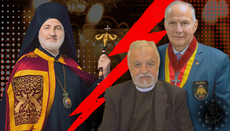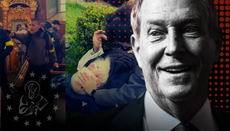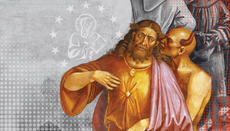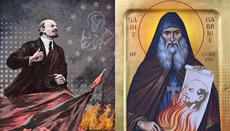The Feast of Pokrov – a Prayerful Remembrance of the Mother of God’s Heavenly Protection
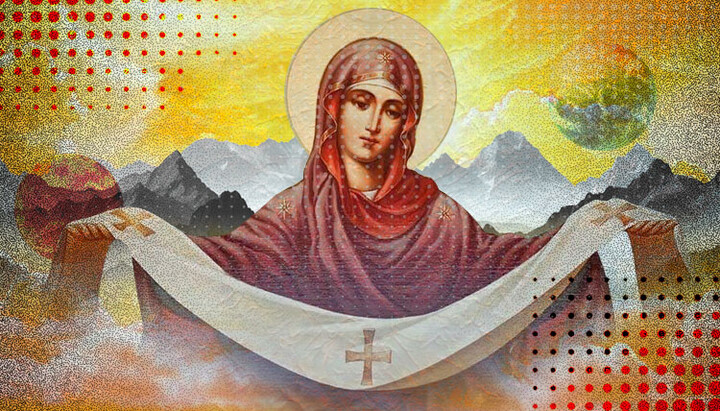
The Feast of the Protection of the Most Holy Theotokos is celebrated in memory of the miraculous appearance of the Mother of God at Blachernae in Constantinople, as a sign of Her protection over Christians.
originally published by our Ukrainian Branch (UOJ-SPZh)
The faithful people of God have always felt the special help of the Most Holy Theotokos. In the most difficult moments, when strength was failing, they turned with prayer to the Queen of Heaven, and She immediately came to aid—and continues to do so today. One such story is remembered today.
The Miracle at the Blachernae Church
The beginning of the 10th century. Constantinople, the capital of the Byzantine Empire, was surrounded by countless Saracen armies. The situation seemed hopeless. Yet the city’s inhabitants, gathering their last remaining strength, came to the Blachernae Church, where, together with the imperial family, they fervently prayed to God for deliverance.
During the all-night vigil, the Most Holy Theotokos herself appeared in the church, accompanied by angels and a host of saints.
Rising above the faithful, She joined their prayers, and then, as a sign of protection from visible and invisible enemies, She spread Her radiant Omophorion (veil) over them.
This miraculous vision was seen by only two of the worshippers: Saint Andrew the Fool-for-Christ and his disciple Epiphanius. Yet soon the story spread to all the city’s inhabitants. Encouraged and filled with hope, they strengthened their faith anew, and the formidable enemy was soon driven from the walls of Constantinople.
According to another, more common version in the Slavic tradition, this miracle is connected with the Rus’ campaign against the Byzantine capital in 860, thwarted through the prayers of the Most Pure Virgin. But regardless of historical details, the spiritual essence of the miracle remains unchanged.
The Protection of the Cossack Army and the Church
The memory of the Theotokos’ intercession was carefully preserved, and in honor of this event the Feast of the Protection was established. In the Ukraine, this feast is especially revered, as the Mother of God became the patroness of the Zaporizhian Cossacks. According to tradition, in 1641, during the Turkish siege of Azov fortress, the Cossacks found themselves in a situation similar to that of the inhabitants of Constantinople centuries earlier. Eight thousand Cossack warriors faced a vast army of Janissaries and Tatars.
The siege lasted over three months, and the Cossacks’ strength was exhausted. Yet they did not despair and prayed fervently. On the Feast of the Protection of the Most Holy Theotokos, a dense fog enveloped the besieged city, and the Cossack army was able to leave the fortress unhindered, reaching the banks of the Don without a single clash with the enemy.
On this momentous day, it is customary to offer fervent prayers for the Orthodox warriors defending their homeland.
Yet our Holy Church also needs protection today, facing persecution and oppression.
Now we see external hostility compounded by internal strife—between brothers and sisters in Christ, between believers and clergy with differing visions for the Church’s future. Amidst such disputes, we often forget that this conflict occurs between co-believers, those whom the Most Holy Theotokos once covered and continues to cover with a single Omophorion.
One Patriarch once said: “The Church is the Body of Christ, crucified for the salvation of its persecutors.” These words remain strikingly relevant today—both sobering and comforting.
Sobering, because our Mother, the Church, is torn today by persecutors and opposing “camps” within the faithful. Comforting, because just as Christ prayed for His executioners on the Cross, He desires the salvation even of those who persecute the Church.
Thus, each of us—whether on the front lines or working in the rear—is called to become a defender of the Church, a prayerful guardian of its unity. And then, in response to our humble prayers, the Most Holy Theotokos will join them with Her mighty intercession, once again covering us with the Omophorion of Her love.
The Lesson of Saints Andrew and Epiphanius: Simplicity and Contemplation
Remembering the miraculous appearance of the Theotokos, we should not forget the two who witnessed it. One was a Fool-for-Christ, the other a blessed soul. By human standards, such people might be considered mentally unwell. Yet in God’s eyes, they attained holiness through their unique spiritual endeavor.
On that day, countless worshippers were present in the church, yet only these two were granted the vision of the miracle.
Externally, they were unremarkable; indeed, their foolishness might have made them appear eccentric. But inwardly, they were distinguished by their special approach to prayer.
In large cathedrals today, we often find that excessive ceremony or general commotion distracts from the essence of prayer. We must quiet the whirl of our thoughts to perceive even a portion of what the choir sings or the reader intones. Saints Andrew and Epiphanius not only prayed inwardly amidst the crowd but also lifted their prayer to the level of contemplation, where the material world ceases to exist for the soul.
Saint Ignatius (Brianchaninov) reminds us that learning to pray should be the lifelong work of every Christian.
The spiritual world is known through simplicity of soul.
We can truly learn to pray only when all superficialities fall away, leaving sincere faith, for without repentance and purification of heart, we can never become true prayerful servants of God.
By following the example of Saints Andrew and Epiphanius, let us strive, in this complex and ever-changing world, to remain sincere toward God and toward others. Simplicity is often mistaken for naivety today—but it is only through such simplicity that genuine prayer is born, the attainment of which should be the aim of every Christian.
UOJ-USA recently reported on the celebration of the Feast of the Robe of the Lord, a feast unique to the Georgian Orthodox Church.


